Farmers, cultivators and their issues: India
This is a collection of articles archived for the excellence of their content. the Facebook community, Indpaedia.com. All information used will be acknowledged in your name. |
Agitations
2011-20
November 26, 2020: The Times of India

From: November 26, 2020: The Times of India
Why farm protests have become more frequent
NEW DELHI: Armed with sticks and rocks, thousands of farmers from various states are marching towards Delhi to protest against the new farm laws cleared by Parliament in September. The protest march is reminiscent of several agitations held by farmers in recent times over a range of issues, including land allocation deals, loan waivers, suicide rates, and minimum support price (MSP). In fact, India has witnessed a worrying rise in protests, clashes and riots related to agrarian distress over the past few years, shows data.
As per data from 2014 to 2018, there have been more than 13,000 protests by farmers on various agrarian issues. These protests have seen a sharp increase over the years, having escalated by eight times from a little over 600 in 2014 to more than 4,800 in 2016.
Major farm protests, 2011-20
|
|
|
|
|
|
|
|
|
|
|
|
|
|
|
|
|
|
|
|
|
|
|
|
|
|
|
|
|
|
|
|
|
|
|
|
|
|
|
|
|
|
|
|
|
|
|
|
|
|
|
|
|
|
|
|
|
|
|
|
|
|
|
|
|
|
|
|
|
|
Government officials admit that frustrated farmers have taken out their anger on the roads in the last couple of years with some major protests reported from states like Madhya Pradesh, Bihar, UP. They said it's due to issues like shrinking of farmlands, failure of crops, poor irrigation facilities, bad seeds, drought, debts etc.
According to 2017 NCRB report, the maximum number of riots related to agrarian distress were reported from Bihar (2,342 cases), almost double the number registered in 2015 (1,156 cases). This was followed by 1,709 riots involving farmers reported from Uttar Pradesh in 2016, while only 752 such incidents were reported from the state in 2015.
A look at the timeline of farmers' protest over the last 10 years show that the minimum support price (MSP) for various crops has been a major grouse. Another issue has been that of land acquisition, with farmers complaining that compensation for land acquired for industrial projects was not in tune with market rates.
‘Farmer agitations reflect clout more than distress’
SA Aiyar, April 8, 2018: The Times of India
The farmers’ march in Maharashtra last month got much sympathy from a public fed on stories of rising farm suicides. But the agitating farmers demanded waivers of all farm loans and electricity dues. Such outrageous demands for freebies may impress politicians wooing the farm lobby, but will not improve justice or fairness.
Rising farmer agitations are not good indicators of rural distress. Rather, they reflect high returns to agitations, increasing the incentive to organise and make new demands. Farm loan waivers have been granted by UP, Maharashtra, Rajasthan, Karnataka and Punjab. Many states provide free farm electricity. Meanwhile non-performing bank loans for agriculture are up from 2% to 6%. One reason is that farmers default, hoping their dues will soon be waived.
The biggest farmers get the biggest bank loans. Marginal farmers and labourers get little or no formal credit, and borrow at extortionate rates from moneylenders. Waiving bank loans will fatten the richest while neglecting those in real need.
Some farm families own hundreds of acres, and one farmer in Punjab has 150 tubewells. Most small farmers have no tubewell at all. So free electricity benefits the biggest and richest farmers. Landless labourers are far poorer than farmers, but get no benefit from loan waivers or free electricity. The Modi government promises higher food prices to help farmers, but this will hit labourers, for whom cheap food is a blessing.
Farmers are a powerful lobby across the world, even in rich industrialised countries like the US. In India, rural areas represent two-thirds of the population and almost half of all employment, so they have much political clout. State governments have been falling over one another to woo the farm vote bank. The fact that loan waivers and free power mostly benefit large farmers and not poor labourers is hardly mentioned in media debates.
One reason is that the public has been fed with stories of rising farm suicides, so nobody wants to be accused of promoting such suicides. Sorry, but there is nothing special about suicide rates of farmers, and they are not rising. The national suicide rate has historically been in the region of 10-11 deaths per one lakh of population, not very different from the rate globally or in rich countries like the US. Indian farmers have a lower suicide rate than non-farmers.
In a 2012 research paper in The Lancet, Vikram Patel and others found that suicides among unemployed persons and those professions outside agriculture were, collectively, thrice as frequent as among farmers and agricultural labourers. Suicide rates are 10 times higher in southern states than northern ones, mainly for cultural reasons. Former Niti Aayog chief Arvind Panagariya showed that barely 25% of rural suicides were farm-related.
Some other studies using a narrow definition of farmers claim that farmers have a higher suicide ratio than others. The question remains whether farmers should be defined as self-cultivators, cultivators plus agricultural workers, or all persons connected with agriculture. Broadly speaking, almost half of Indian households claim to be employed in agriculture. On any broad basis, the farm suicide rate is lower than the non-farmer rate.
Puducherry, with little agriculture, has the highest suicide rate among states, followed by Kerala. This surely has nothing to do with low farm prices. Anuradha Bose in The Lancet in 2004 found that the suicide rate among Tamil girls aged 10-19 was 148 per lakh people. This is over ten times the farm suicide rate, yet the latter hogs the headlines. Depression and mental health are the main causes of suicides, which is why rich nations also suffer, but nobody discusses this problem. Official data shows farm suicides rose from around 11,000 in 1995 to 18,241 in 2004, and then fell substantially. Farm suicides fell to 12,602 in 2015 and 11,370 in 2016. This is hardly 8% of total suicides, although almost 50% of the population is engaged in farming. The accuracy of suicide data can be questioned, but the overall trend shows declining, not rising distress.
A reply to a Lok Sabha question showed suicides rising among agricultural labourers (from 4,595 in 2015 to 5,019 in 2016) even as they fell among land-owning farmers (from 8,007 to 6,351). This suggests rural distress is greater among labourers than farmers.
Let me repeat a suggestion made in an earlier Swaminomics column. If farmers are to be aided, the best way is a flat subsidy of Rs 4,000 per acre per cropping season, up to a limit of five acres, while ending other subsidies. This will provide a safety net without distorting farm prices and production.
The agrarian crisis and the political class
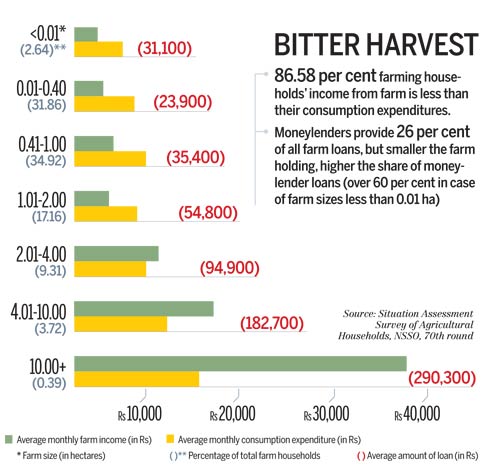
May 11, 2015
Ravish Tiwari
The political class has read the agrarian crisis wrong. It's about time rhetoric met reality
Gajendra Singh : In his death, Gajendra Singh gave the political class much to outrage over. And outrage they expressed, but mostly over the wrong reasons. The middle-aged man from a farming family in Rajasthan's Dausa district hanged himself at a farmers' rally organised by Delhi Chief Minister Arvind Kejriwal at Jantar Mantar on April 22, 2015. Almost immediately, the televised suicide was taken over by the opposition parties to rail against the Narendra Modi government's land acquisition ordinance, equating Singh's death, and those of other farmers, with the law.
There's very little, however, to suggest any connection between land acquisition and either the rising level of agrarian crisis or the overall number of farmers who took their own lives. And those numbers have in fact declined in the last 10 years until 2013, says the National Crime Records Bureau. But in their attempt to score brownie points, the politicians seemed to be barking up the wrong tree. Discussions in both houses of Parliament focused mostly on easy solutions to the crises, virtually ignoring deeper structural issues that need political solutions.
Not that agrarian crisis is a non-issue. Far from it. The 2011 Census estimates 168 million of India's total 247 million households are in rural areas. The "Situation Assessment Survey of Agricultural Households", conducted during the 70th round of the National Sample Survey Office (NSSO) held in 2013, says only 90.2 million of those 168 million rural households are engaged in agriculturally productive operations. But that's not the problem. The assessment survey suggests that farmers involved in farming operations on land up to 2 hectares (ha)-the small or marginal farmers-cannot meet even their average monthly consumption expenditure from only incomes generated from farming (cultivation and animal husbandry). It says as many as 78.1 million of the 90.2 million farming households (86.6 per cent) do not earn enough from farming to meet their expenses. And that is where the problem lies.
Fragmented ownership
A NABARD paper released in February 2015 suggested that the average size of operational landholdings has reduced by half in the last 40 years-from 2.28 ha in 1970-71 to 1.16 ha in 2010-11. As a result, the number of landholdings in the marginal and small categories have swelled by 56 million and 11 million, respectively. NABARD's assessment of unviability of smaller farms, in a way, has been validated by NSSO survey results made public in December 2014, which say only farms more than 2 ha are yielding more income than farmers' consumption expenditure.
The solution then lies in arresting this fragmentation and consolidation of farms-a task the political class needs to take up forthwith. "The answer lies in farmers getting together to collectivise farmlands; not Soviet collectivisation but taking the shape of producer companies. (It requires a) limited form of cooperation where a farmer does not give his land away but cooperates for input purchases and selling of the produce," says noted agricultural economist Y.K. Alagh.
Ramesh Chand, director, National Centre for Agricultural Economics and Policy Research (NCAP), suggests a regulatory framework to facilitate legal leasing of farmland to ensure security and stability for farmers. India's land lease laws are based on conditions dating back to Independence, which makes many farmers unwilling to lease out land. "Or those who want to take farms on lease don't get it," Chand says. "Farmers prefer to keep land fallow rather than lease them out; they fear they would lose control."
For the political class, the challenge lies in fragmentation of landholdings that are getting unviable. Agriculture administrators recommend proliferation of oral or informal leasing/renting of farmland to advocate a legal framework to protect landowners and facilitate consolidation of landholdings.
Race for insurance
If this was the winter of discontent for farmers in most parts of north India, the spring arrived with little hope. The unseasonal rain and hailstorm in patches ravaged standing crops on nearly 189 lakh ha of about 606 lakh ha of rabi acreage. The twin demands that arose as a result were of central relief by state governments and relaxation of procurement norms by farmers to ensure their spoilt crop is assured of a market.
As expected, the political rhetoric has hit the high notes: in Parliament, ruling NDA MPs were keen to highlight the Centre's call to relax relief disbursement norms, while the Opposition panned the government for its failure to release more funds to states promptly. Lost in this politicking was the fine difference between relief and compensation. Lesson for politicians: the Centre provides relief if crops fail, but the need of the hour is to insure them.
Farmers are hardly out of the woods once the yield comes out good and is harvested. The next part of the harrowing journey only begins then. And one merely needs to follow the Gangetic plain eastward to hear complaints of farmers in Uttar Pradesh, Bihar and West Bengal about their produce remaining unsold, or being sold below the minimum support price (MSP).
"Farm holdings are so fragmented in eastern India that farmers find little merit in incurring transportation cost to procurement centres. This allows aggregators, traders to purchase the produce at the farm gate instead of the mandi (wholesale), and that is usually below the MSP," says Ashish Bahuguna, former agriculture secretary.
While the political leadership of Punjab and Haryana, the original Green Revolution states, have institutionalised their procurement networks, political leaders elsewhere, especially in the Gangetic plain, need to learn a lesson from Madhya Pradesh and Chhattisgarh Chief Ministers Shivraj Singh Chouhan and Raman Singh respectively. The two CMs have given a sustained push to a sound procurement network for wheat (MP) and paddy (Chhattisgarh) farmers, and thereby good price for their crops.
Not unlike the politicians, the prevailing laws also do not help much. Both the Agricultural Produce Market Committee Acts and the Essential Commodities Act have patronised traditional and entrenched traders and have not allowed modern trading, and need to be amended. Political leaders need to mull over how to modernise domestic trade to facilitate modern capital infusion to create logistics and storage facilities.
Fight for inputs
The entire political class may take pride in India's agricultural tradition, but most farmers still continue to struggle for basic inputs such as seeds, fertiliser pesticide, irrigation, power and credit. There was a large-scale disruption in fertiliser supply only last year, raising the political heat in several parts. "Inputs such as seed and fertiliser need to be available on time. Fertiliser requirements for kharif crops should be tied up at the end of the previous rabi crop," points out Gurbachan Singh, for-mer federal agriculture commissioner and now chairman of the Agricultural Scientists Recruitment Board.
"The political class should be alive to the demand forecast rather than react to a crisis generated by (their) misgovernance. Political pressure should ensure proactive coordination between placing orders, ensuring movement (of fertiliser) and timely distribution," says Ajay Vir Jakhar, chairman, Bharat Krishak Samaj.
The political class also needs to learn from state governments such as Shivraj Singh Chouhan's to expand irrigation coverage to reach the benefits to farmers. Similarly, for power supply for irrigation and other operations they need to look at Rajasthan, Gujarat, Andhra Pradesh, Haryana, Punjab, Karnataka, Maharashtra and Madhya Pradesh, which have demonstrated efficacy of separate agricultural feeders for farmers.
As for agriculture credit, though it has jumped to more than Rs 8 lakh crore, Ramesh Chand underlines the wide inequality in institutional credit between states.
There's a lot to be learnt for politicians to address the varied crises farmers face. As India looks at a year of below-normal monsoon, it's important that they show outrage over deaths such as that of Gajendra Singh's. But that fury has to be for the right reason for it to have any lasting effect.
Political parties unaccountable to farmers
Apr 27 2015
Dhananjay Mahapatra
Parties must rise above politics over farmer deaths
We have been told that agriculture is the mainstay of the Indian economy . Monsoon gives life to agriculture. The agricultural workforce reinforces India's granaries and ensures its food security . If agriculture occupies a pivotal role, why have governments in 65 years not been able to improve the plight of the farm workforce? At the same time, land owners have flourished. They own huge tracts of land, which helps them acquire money , muscle and political influence. In contrast, farmers have remained on the fringes. Over the years, ruling parties have tom-tommed policy decisions to sanction easy farm loans and later, write them off. Who benefits the land owners or the farmers? To take a loan, a farmer has to show that he has land. A small percentage of farmers own land. So, loans are cornered by land owners. When loans are written off, its double benefit for them.
Most land owners give their land for farming on contract basis. The usual contract is the farmer will till the land, sow the seeds, water the crop and look after it. At harvest time, the land owner will take either onethird or half the crop. To buy seeds, fertilizer and other farm requirements, the farmer needs money . He takes loan, not from banks but village money-lenders at hefty rate of interest. Given the inadequate irrigation system, most farmers feel the heat in a bad monsoon year. Failed crop means loan defaults. Spiraling interest soon overtakes the principal, due to which the trapped farmers seek release by embracing death.
A farmer's death at the AAP rally at Jantar Mantar showed us yet again the eagerness of parties to score brownie points, unmindful of the fact that our policies have failed to ensure a better life for those who take care of our food and fill our granaries.
All parties behaved as if this death exemplified the present situation of farmers.Irrespective of the party in government in various states, thousands of farmers have ended their lives over the years to escape the debt trap. The party which sold dreams to hitch a ride to power says it is not even a year-old and blames the previous party which was in power. But no one has given a concrete policy framework providing farmers an honourable release from the debt trap.
The farmers' plight was explained vividly by the Supreme Court in its December 14, 2010 judgment in Maha rashtra vs Sarangdhar Singh Shivda Singh Chavan case. It was about the illegal money lending (at the rate of 10% interest a month) racket in Maharashtra. The petitioners said, “Nearly 300 farmers have committed suicide in Vidarbha as victims of such illegal money lending business and the torture perpetrated by the recovery of such money . A complaint has been made that the farmers do not get the benefit of various packages announced by the government and the state machinery is ruthless against farmers.“
The collector of Buldhana, on instructions of the then Congress CM, had ordered non-registration of police case against a money lender, Gukulchand Sananda, and his family , despite 50 complaints against them.The SC had sought explanation from the ex-CM, who in 2010 was Union minister for heavy industries. The exCM didn't deny the charge of his office asking the collector not to register a case against the Sananda family .
The SC quoted National Crime Records Bureau data to say that nearly 2 lakh farmers committed suicide in India between 1997 and 2008. Two-thirds of the 2 lakh suicides took place in five states Maharashtra, Andhra Pradesh, Karnataka, MP and Chhattisgarh. The SC drew a pathetic contrast, saying, “Even though Maharashtra is one of the richest states in the country and 25,000 of India's one lakh millionaires reside in its capital Mumbai, the Vidarbha region is today the worst place in the whole country for farmers. The position is so pathetic in Vidarbha region that families are holding funerals and weddings at the same time and some times on the same day .“
In the verdict's concluding paragraph, the SC had said, “This court is extremely anguished to see that such an instruction could come from the chief minister of a state which is governed under a Constitution which resolves to constitute India into a socialist, secular, democratic republic. CM's instructions are so incongruous and anachronistic, being in defiance of all logic and reason, that our conscience is deeply disturbed.We condemn the same in no uncertain terms.“
Such serious judicial condemnation did not cast any shadow on the politician's career. He merrily continued in the UPA cabinet. None he himself, his party or the prime minister -suffered any moral pang.
“ BJP’s rural votes indicate farm crisis exaggerated”: 2018-19
SWAMINATHAN S ANKLESARIA AIYAR, June 2, 2019: The Times of India
BJP’s rural votes show talk of farm crisis misleading
Annual GDP growth fell from 6.9% in 2017-18 to 6.8% in 2018-19. Worse, GDP in the latest January-March 2019 quarter slowed to just 5.8%. Yet Narendra Modi swept the general election. The BJP’s national vote share rose from 31.3% to 37.5%. In the seats it contested, its vote share rose to 46%. Contradicting conventional wisdom on agrarian distress, the BJP actually boosted its vote share in rural areas to roughly 46%, double the Congress’ 23%.
This suggests that talk of agrarian distress is much exaggerated. The latest data shows that agricultural growth in 2018-19 was 2.9%. Growth fell quarter after quarter — 5.1%, 4.9%, 2.8% and -0.1%. Clearly a good rabi and summer crop in 2018 was followed by serious slowing because of drought.
But the annual average of 2.9% is the highest ever in a drought year. This heart-warming achievement reflects increasing irrigation plus diversification into animal husbandry, fisheries and tree crops that are less monsoon-dependent. Indeed, traditional crops now account for barely half the agricultural output. Maharashtra was the worst-hit drought state in India, yet the NDA won 41 of the 48 seats there, and the Congress only one.
Congress apologists argue that Modi diverted voter attention from agrarian distress to the Balakot bombing, highlighting the need for a strongman to enhance national security. But the very fact that economic issues could so easily be overwhelmed by security issues proves that the economy is not in such bad shape. Yes, there is a slowdown. That always causes some pain. But it does not amount to a crisis. That word is seriously overused.
No country has managed more than 3% agricultural growth over a long period. The main reason is that you can build more factories to boost industry and more offices to boost services, but you cannot create more land to expand agriculture. Indeed, with growing urbanisation, India’s cultivated area is falling. So, all gains have to come from higher productivity.
Globally, agricultural productivity has grown historically at barely 2% a year. India’s potential is higher than in some other countries because of catch-up possibilities. Yields in India are far below those in China or Egypt. Even so, calling India’s agricultural growth of 2.5 -3% in the last decade an “agrarian crisis” is simply wrong.
Between 2004-05 and 2011-12, India raised 138 million people above the poverty line. We still await the 2017-18 data. But the World Poverty Clock, an internationally recognised source of quick estimates, says the number in India below the World Bank’s poverty line of $1.90 per day has fallen from 218 million in 2011-12 to barely 50 million in 2018. That would be impossible if India really had an agrarian crisis.
Farmer agitations have risen. They are equally common in rich countries where farmers earn 100 times more. Rising agitations reflect rising returns from demonstrations as governments give in, not distress. Distress was worst in the twin droughts of 1965-66 but there were no agitations, just starvation.
The main rural problem is that rising population has reduced the average farm size to 1-2 acres. Prosperity on such tiny plots is impossible. Agriculture accounts for barely 13% of GDP today but almost 50% of employment. The answer is to move people massively out of agriculture into industry and services.
India has failed there. Its labour laws have prevented the emergence of giant factories (as in China and Bangladesh) with tens of thousands of workers. So, ironically, the biggest rural problem is labour legislation. A massive shift of people out of agriculture would help double or triple farm size.
In poor Bihar and eastern UP, villagers say farming and MNREGA occupies them for only a few months in the year. This looks insufficient to account for rising ownership of cellphones, TVs and motor cycles. Villagers say this is explained by virtually every rural family having one or more members working in a town, often within commuting distance, sending or bringing home remittances. This rural diversification is not captured by statistics. Besides, the arrival of roads, electricity and telecom in almost all villages has created many new rural economic opportunities, from dhabas and repair shops to agro-processing. Doubtless Modi’s charisma is the overwhelming reason for the BJP’s electoral success. It lost state elections in Rajasthan, Madhya Pradesh and Chhattisgarh five months ago when voters were choosing a chief minister. But even there the BJP vote share was almost as high as the Congress. There is indeed short-term distress because of the drought and long-term distress because of shrinking land per person. But to call this a crisis is very misleading. Modi’s victory proves that.
Agrarian crises, flashpoints, distress signals
As in 2018
Surojit Gupta, 10 REASONS WHY FARMERS ARE IN DISTRESS, December 13, 2018: The Times of India

Value of agricultural output
Value of manufacturing production
Share of agriculture & manufacturing in states' GDP
Per capita GDP
From: Surojit Gupta, 10 REASONS WHY FARMERS ARE IN DISTRESS, December 13, 2018: The Times of India
1 Two years of drought
Two successive years of drought (2014, 2015) have taken a toll on the farm sector. The government has allocated significant funds for the sector but slow implementation of projects has not eased the pain. Drought in Maharashtra, Gujarat and Karnataka have also added to farmers’ woes
2 Collapsing farm prices
Prices have collapsed for farm commodities. Low international prices have meant exports have been hit while imports have hurt prices at home. For example, there was a bumper production of pulses in 2016-17 but imports of nearly 6.6 million tonnes arrived, compounding the problem. In 2017-18, another 5.6 million tonnes flowed in, depressing domestic prices further. The government delayed imposing tariffs on imports, which heightened the problem of prices for farmers. According to a Niti Aayog paper, on average, farmers do not realise remunerative prices due to limited reach of the minimum support prices (MSP) and an agricultural marketing system that delivers only a small fraction of the final price to the actual farmer
3 Insurance fails to serve
The Pradhan Mantri Fasal Bima Yojana was launched in 2016 to provide insurance and financial support to farmers in the event of failure of any crops due to natural calamities, pests and diseases. It was also meant to stabilise the income of farmers and ensure they remain in farming. But the scheme has seen lower enrolments due to a string of factors, including high premiums and lack of innovation by insurance firms
4 Irrigation takes a hit
Irrigation is crucial for the farm sector, where large tracts of land still depend on monsoon rains. The Centre launched the Rs 40,000-crore Long-Term Irrigation Fund, operated by the National Bank for Agriculture and Rural Development (Nabard). Under this programme, 99 large irrigation projects were to be completed by December 2019 but the progress so far has been limited. Experts say a number of factors, including bureaucratic delays and slow implementation by states, have hurt progress for this crucial input
5 Marketing is ignored According to a Niti Aayog document, farm sector development has ignored the potential of marketing. Archaic laws still hobble the sector. Access of farmers to well-developed markets remains an issue although several initiatives have been launched to develop an electronic market place. Reforms to the APMC Act have been slow and most states have dragged their feet on it. Experts suggest an entity such as the GST Council to bring together states and the Centre to jointly take decisions to reform the sector and provide better access to markets for farmers. According to the Organisation for Economic Cooperation and Development (OECD), the combination of market regulations and infrastructure deficiencies leads to a price depressing effect on the sector
6 Modern tech missing
Introduction of latest technology has been limited due to a number of reasons. Access to modern technology could act as a boost to productivity through improved variety of seeds, farm implements and farming technology. According to a Niti Aayog paper, there has been no real technological breakthrough in recent times
7 Fragmented supply chains
Large gaps in storage, cold chains and limited connectivity have added to the woes of farmers. It has also added to the significant post-harvest losses of fruit and vegetables, estimated at 4% to 16% of the total output, according to the OECD
8 Lack of food processing clusters
This has meant that there is little incentives for farmers to diversify. According to an OECD document, share of high-value sectors in food processing is low with fruit, vegetable and meat products accounting for 5% and 8% of the total value of output compared to cerealbased products at 21% and oilseeds at 18%
9 Delayed FCI reforms
A government-appointed panel had recommended that FCI hand over all procurement operations of wheat, paddy and rice to states that have gained sufficient experience in this regard and have created reasonable infrastructure for procurement. These states are Andhra Pradesh, Chhattisgarh, Haryana, Madhya Pradesh. It had suggested a complete overhaul of FCI and recommended that farmers be given direct cash subsidy (of about Rs 7000/ha) and fertiliser sector deregulated. The panel had said direct cash subsidy to farmers will go a long way to help those who take loans from money lenders at exorbitant interest rates to buy fertilisers or other inputs, thus relieving some distress in the agrarian sector. The report has been put in cold storage
10 Low productivity
The share of the farm sector in GDP has declined from 29% in 1990 to about 17% in 2016, but it remains a major source of employment. According to OECD data, 85% of operational land holdings are less than 2 hectares and account for 45% of the total cropped area. Only 5% of farmers work on land holding larger than 4 hectares, according to the Agricultural Census, 2016. Productivity lags other Asian economies such as China, Vietnam and Thailand and average yields are low compared to other global producers. Wheat and rice yields are nearly 3 times lower than world yields while those for mango, banana, onion or potato are between 2 and 7 times lower than the highest yields achieved globally, according to the OECD
Agriculture census
2010-11
9th December 2018: Press Information Bureau
Department of Agriculture, Cooperation& Farmers Welfare has released Agriculture Census 2010-11(Phase-II). Highlights of the Census are:
Highlights
As per Agriculture Census 2010-11,
· Total number of operational holdings were estimated as 138.35 million.
· The total operated area was 159.59 million hectare.
· The average size of the holding has been estimated as 1.15 hectare. The average size of holdings has shown a steady declining trend over various Agriculture Censuses since, 1970-71.
· The Size Group wise percentage of number and area of operational holdings are given in the following table.
|
Sl.No |
Size-Group |
Percentage of number of operational holdings to total |
Percentage of area operated to total |
|
1 |
Marginal (below 1.00 ha.) |
67.10 |
22.50 |
|
2 |
Small (1.00 - 2.00 ha.) |
17.91 |
22.08 |
|
3 |
Semi-medium (2.00 - 4.00 ha.) |
10.04 |
23.63 |
|
4 |
Medium (4.00 - 10.00 ha.) |
4.25 |
21.20 |
|
5 |
Large (10.00 ha. & above) |
0.70 |
10.59 |
· The Gross Cropped Area (GCA) was estimated at 193.76 million hectare.
· The nine States, viz., Andhra Pradesh, Karnataka, Gujarat, Madhya Pradesh, Maharashtra, Rajasthan, Uttar Pradesh, Punjab, and West Bengal together account for about 78 per cent of the Gross Cropped Area in the country.
· Out of the total 64.57 million hectare Net Irrigated Area, 48.16 percent is accounted by Small and Marginal holdings, 43.77 percent by Semi-medium & Medium holdings and 8.07 percent by Large holdings.
· The Cropping Intensity as per Agriculture Census 2010-11 works out to 1.37.
· For 96.95 per cent of operational holdings, entire operated area was located within the village of residence.
· Among various sources of irrigation, Tube-wells was main source of irrigation followed by canals.
All India level, during 2010-11, the proportion of net irrigated area to net area sown was 45.70 percent.
Agriculture Census in India is conducted at five yearly intervals for collection of information about structural aspects of agricultural holdings in the country. The basic statistical unit for data collection is ‘Operational Holding’. The reference year for the present Census was Agriculture Year 2010-11 (July-June). Agriculture Census data is collected in three phases. During Phase-I, data is collected on primary characteristics such as number and area of operational holdings. In Phase-II, detailed data is collected on sample basis from 20 per cent villages covering characteristics such as tenancy, land use, irrigation, cropping pattern, dispersal of holding etc. During Phase-III, generally referred to as Input Survey, data is collected on pattern of use of inputs.
|
Sl.No. |
Category |
Operated Area |
|
1 |
2 |
3 |
|
1 |
Marginal holdings |
Below 1.00 hectare |
|
2 |
Small holdings |
1.00 -2.00 hectares |
|
3 |
Semi-Medium holdings |
2.00 - 4.00 hectares |
|
4 |
Medium holdings |
4.00 - 10.00 hectares |
|
5 |
Large holdings |
10.00 hectares and above |
The concept of agricultural operational holdings does not include those holdings which are not operating any agricultural land and are engaged exclusively in livestock, poultry and fishing etc. On the basis of operated area, operational holdings in Agriculture Census are categorized as follows:-
The results of Phase-I and Phase-II of Agriculture Census 2010-11 have already been finalized and released. The detailed data /tables of Agriculture Census are available in the website of the Department at http://agcensus.nic.in. The All India Report of Agriculture Census 2010-11 is based on the data collected during Phase-II of the Census.
1970-2016: farm size shrinks, women landowners rise
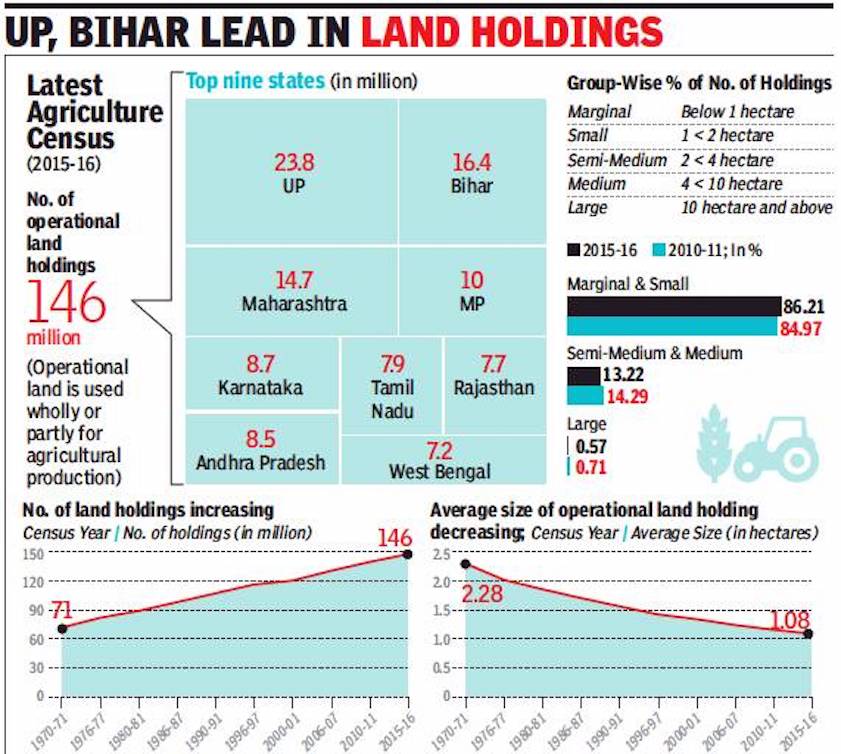
From: Vishwa Mohan, Slide in farm size, but women landowners rise: Agri census, October 2, 2018: The Times of India
The increase in farmland holdings, a consistent trend since the 1970s, has been slowing down in the past 20 years but there is a rise in the number of female landholders, a possible indicator of higher involvement in farm activities, the provisional agriculture census 2015-16, has revealed.
The trend could mean the association of farming with “kisan bhai (farmer brothers)” might be less exclusively a male domain than popular belief has it. The trend may reflect migration of men to cities for non-agricultural activities and also explain slowing down of land division as rural people seek alternate livelihoods.
The figures show landholdings have doubled in past 45 years (from 71million in 1970-71 to 146 million in 2015-16), resulting in decline in average size of farms by more than 50% — a real worry for policy-makers as this makes agriculture unremunerative for farmers.
But the pace of such division is declining. Number of land holdings increased by 12% from 1995-96 to 2000-01, 7.5 % after that till 2005-06, 6.9% by 2010-11and 5.33% till 2015-16.
The agriculture census is carried out at five-year intervals as part of the world agriculture census programme. The first census in India was conducted in 1970-71. Data provides valuable inputs to policy makers as they plan various intervention.
The current agriculture census is the 10th in the series whose final figures, comprising other details, are expected to be released by December. According to provisional data, the percentage share of female land holders increased from 12.79% (17.65 million) in 2010-11 to 13.87% (20.25 million) in 2015-16. Their numbers were nearly 11% ( 15.11 million) in 2005-06.
Decreasing size of land holdings, however, remains a serious challenge. Being the final unit for agriculture-related decisions, an operational holding has been taken as statistical unit at micro-level for various policy interventions.
Landholdings
Vishwa Mohan, UP to gain most from PM’s farm proposal, February 3, 2019: The Times of India
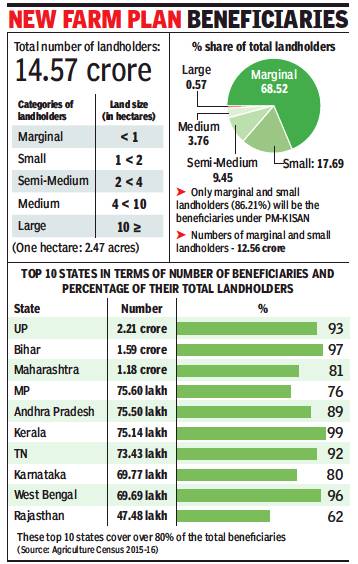
From: Vishwa Mohan, UP to gain most from PM’s farm proposal, February 3, 2019: The Times of India
In Percentage Terms, Kerala Top Beneficiary
Uttar Pradesh may be the biggest beneficiary of the Centre’s assured income support programme due to sheer number of small and marginal landholders in the state, but it is Kerala which figures at the top if one looks at the data in percentage term as over 99% of the farmers there have landholdings of less than five acres.
Under the income support programme (PM-KISAN), announced in the government’s interim budget on Friday, the Centre will annually provide Rs 6,000 each to only those over 12 crore landholders who have cultivable land of less than five acres (two hectares).
State-wise figures of such landholders show that over 50% of total beneficiaries will collectively be from five states with the highest of them (2.21 crore) coming from UP, followed by Bihar (1.59 crore), Maharashtra (1.18 crore), MP and Andhra Pradesh (over 75 lakh each). Over 80% of total beneficiaries will come from 10 states where Kerala figures at the top in percentage terms followed by Bihar, West Bengal, UP and Tamil Nadu. Except Bihar and West Bengal, all the states in the list along with Telangana have adequate digital land records.
These figures are part of the 2015-16 agriculture census, released late last year, which will be the basis of implementing the assured income support programme while arriving at corroborative land data.
Union agriculture minister Radha Mohan Singh confirmed to TOI about making the 2015-16 census as the basis of implementing the programme. The ministry on Friday wrote to all states asking them to share their digital land data base comprising details of beneficiaries including name, gender and SC/ST status. States which don’t have complete records in digital formats may share their data of beneficiaries of various schemes.
The Centre will issue detailed guidelines for the implementation of the scheme in the next two-three days and appoint link officers in agriculture ministry for each state for monitoring.
Asked how the Centre would arrive at exact data of beneficiaries for properly implementing the scheme, additional secretary in agriculture ministry Ashok Dalwai said, “It’ll be implemented through electronic medium so that money is transferred directly to the farmers’ ‘Jan Dhan’ accounts”.
Agriculture reforms
The best performing states, 2015
Maha tops Niti Aayog's agriculture reforms index. Nov 01 2016 : The Times of India
66% Of States Fail To Reach Half Way Mark
Maharashtra is on top of the ladder, followed by Gujarat and Rajasthan, in Niti Aayog's index reflecting states' performance in undertaking agriculture and farm sector reforms.
The first-ever such index, by Niti Aayog, is aimed at ranking states on the basis of implementing agriculture marketing reforms and ease of doing agri-business.
States like Bihar, Kerala and Manipur are not included in the ranking because they either did not adopt Agricultural produce market committee (APMC) or revoked it. “We are talking to them as we think this is not the best thing to do,“ said Ramesh Chand, member of Niti Aayog. Almost two-third of the states could not reach even half way mark of reform score of the index. Major states like UP , Punjab, West Bengal, Assam, Jharkhand, Tamil Nadu and J&K, have poorly performed .
As per the states' score in the in dex, Madhya Pradesh ranked fourth, followed by Haryana, Himachal Pradesh, Andhra Pradesh, Karnataka, Telangana, Goa and Chhattisgarh.An official said, “The index is aimed at helping the states to identify and address problems in the farm sector, which suffers from low growth, low income and agrarian distress.“
Stressing on urgent need to push reforms in the farm sector, Niti Aayog vice-chairman Arvind Panagariya said that post 1991, reforms focused on non-agriculture sector. “Reforms did not focus on the agri sector. One effort was made in 2003 through the model APMC Act reform and some progress was made but not enough and that has led to gap between industry and services on one hand and agri on other hand,“ he added.
The areas identified by Niti Aayog with a view to double farm income include agriculture market reforms, land lease reform, and reforms related to forestry on private land.
Use of modern techniques
The Times of India, Apr 27 2015
Between the 1940s and 1960s, research helped many countries increase agricultural yields. The yield per hectare is an indicator of the use of modern techniques like mechanisation and use of high-yielding varieties as well as improvement of traditional infrastructure like irrigation. The World Bank includes wheat, rice, maize, barley, oats, rye, millet, sorghum, buckwheat and mixed grains to calculate cereal yields. A comparison of India with other major economies shows that India's cereal yield is among the lowest. In 2013, cereal yield in the US was about two and half times that of India.
‘Big’ landholders
2015-16
Vishwa Mohan, June 4, 2019: The Times of India
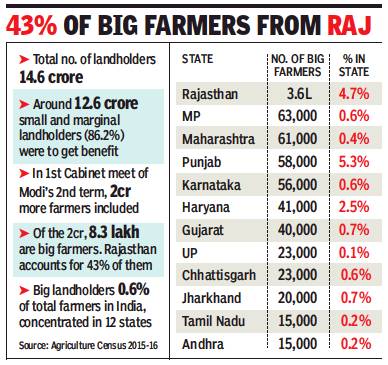
From: Vishwa Mohan, June 4, 2019: The Times of India
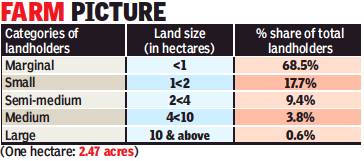
From: Vishwa Mohan, June 4, 2019: The Times of India
Though such big landholders account for merely 0.6% of total farmers in India, their numbers in some states, such as Rajasthan, Madhya Pradesh, Maharashtra, Punjab, Karnataka, Haryana and Gujarat, are high.
Analysis of state-wise figures on landholders shows that 5.3% of total farmers in Punjab are large ones. Similarly, 4.7% of total farmers in Rajasthan and 2.5% in Haryana are big in terms of their landholdings. In other states, however, big landholders make up less than 1% of the total number of farmers due to fragmentation of holdings.
Large landholdings in Rajasthan may not be comparable with similar size of land in Punjab and Haryana in value terms (productivity) if one takes irrigation facilities and soil fertility into account, but the number of large farmers in the arid state presents an interesting picture. Rajasthan alone has 43% (3.6 lakh) out of the 8.3 lakh big farmers in India.
The top 12 states, including Rajasthan, collectively account for 93% of total big farmers in the country. On the other hand, there are 13 states/UTs, including Goa, Sikkim and Delhi, where number of large farmers is negligible. Other than UTs, most of such states are from the north-east. Though Nagaland and Arunachal Pradesh have big landholdings, they are mostly community land.
Among the remaining states, Telangana has 9,000 large farmers followed by Assam and Odisha (4,000 each), Bihar and Himachal Pradesh (3,000 each), Kerala (2,000), and Uttarakhand, West Bengal and J&K (1,000 each).
The figures are part of the Agriculture Census 2015-16.
Contract farming
2018: Centre releases a model act
Vishwa Mohan, May 23, 2018: The Times of India
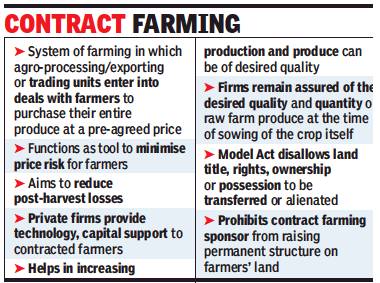
From: Vishwa Mohan, May 23, 2018: The Times of India
Amid estimates of record production of agricultural and horticultural produce in 2018, the Centre released a model act on contract farming and asked states to adopt it to save farmers from price volatility.
The proposed model law - State/UT Agricultural Produce and Livestock Contract Farming and Services (Promotion & Facilitation) Act, 2018 - intends to integrate farmers with agro-industries and exporters for better price realisation by mitigating market and price risks.
Once adopted by states, it will formally facilitate entry of private players into the farm sector as it would induce competition and ensure assured and better price of farm produce to farmers through advance agreements. It can offer assured price to farmers and save them from a problem of plenty -- a situation where farmers opt for distress sale when bumper crops cause a glut in the market. “There is unanimity among the states to adopt the ‘model contract farming and services’ act in its true spirit so as to ensure assured market at pre-agreed prices,” said Union agriculture minister Radha Mohan Singh.
The proposed law was unveiled here in presence of agriculture marketing ministers from several states including Andhra Pradesh, Arunachal Pradesh, Assam, Bihar, Chhattisgarh, Haryana, Madhya Pradesh, Odisha, Rajasthan and Uttar Pradesh.
Economic issues
2017: Mismatch Between Input Costs And Low Returns
Subodh Varma, Farmers' ire not about loans alone, June 10, 2017: The Times of India
Key Reason Behind Anger Is Mismatch Between Input Costs And Low Returns
The farmers' agitation in MP, and before that in Maharashtra, has pushed a simmering agrarian crisis into the spotlight.Earlier, the newly elected UP government announced a loan waver for small and marginal farmers, Maharashtra government said it was exploring the possibility. The Centre itself had announced that it would strive to double farmers' incomes by 2022. All these were raising expectations of farmers, especially after enjoying a good monsoon and record harvest in 2016-17, after two consecutive years of drought. Yet why are farmers the lifeline of India angry and resentful?
One of the key factors fuelling agrarian anger is that good year or bad year, they are unable to earn enough. There is always a mismatch between their cost of production and what they get in the mandis.
A quick comparison of cost of production and farm harvest prices as data collected by the agriculture ministry reveals the mismatch for 201415, the last year for which such information is available. In several states, for several widely cultivated produce like paddy and wheat, prices at which farmers are selling their harvest are actually lower than what they spent in cul tivating the crop.
In Madhya Pradesh, the epicenter of current agitation, paddy was fetching 15% less than cost of production while wheat was giving them just 2% profit. MP has emerged as a major player on the national scene exhibiting an agricultural growth rate of 9.7% between 2005-06 and 2014-15 compared to 3.6% for India as a whole. Share of agriculture in MP's gross state domestic product has increased from 25% to over 30% in this period. Area under vegetables and fruits has increased by 78% since 201011. According to a study done by Ashok Gulati and his colleagues at ICRIER, expanded irrigation, strong procurement system for wheat and bonus over its minimum support price and expansion of all-weather roads to connect farmers to markets have led to this boom in agriculture.Yet, after enjoying the boom for several years, the state's farmers have ended up in the same trap that has been haunting their brethren in other states.
The reason why farmers don't get suitable margins is because of their input costs -water, diesel, fertiliser, etc.
For cultivating wheat in MP, Rs 1,241.34 were spent on fertilisers per hectare in 2004-05 which has more than doubled to Rs 2,695.27 per hectare in 2014-15. Similarly , cost of seeds used in one hec tare increased from Rs 998 in 2004-05 to Rs 2,653 in 2014-15.Even cost of irrigation has jumped from Rs 1,961.50 to Rs 2,599.55 in this period. These and other costs like labour, agricultural machinery hiring charges, pesticides, rents, have all gone up while prices that farmers get have lagged behind. As recently reported, support prices may be higher than what farmers get but getting payments is so difficult that farmers often have to sell to traders at lower prices.
This dire situation is also causing mounting indebtedness of farmers with over half of agricultural households in debt as per an NSSO survey for 2012-13. MP was reported to have 46% debt ridden farmers.
Should farmers diversify to get more value for their crops? This would appear to be a way out except that even in those cases, farmers' margins plummet after some time.UP's potato farmers were getting a measly 5% profit, while in Punjab, cotton farmers have suffered enormous losses of as much as 20%.
2017: Farmer strikes caused by RBI's strong inflation targeting?
`Farmer strikes may have roots in RBI's strong inflation targeting', Jun 10 2017: The Times of India
Food Prices Lower Than Three-Year Average: SBI Report
The recent farmers' agitations across various states may have its roots in the Reserve Bank of India's (RBI's) aggressive stance to target lower retail inflation as this has led to prices, especially of food items, currently being lower than the three-year average.
On the one hand while the government's agri sector reforms are showing results to smoothen out the supply side hurdles, slide in food prices have been much faster because of the RBI's aggressive policies to contain retail inflation, a report by SBI noted.
Food items have about 46% weight in retail infla tion. So to keep the consumer price index (CPI) under the RBI's target of 4%, the rise in food prices should be in the 5-6% range, which has happened at ground level.
Within this category , cereals & products have a 9.7% weight, followed by milk & products with 6.6%, vegetables with 6% and meat & fish with 3.6% weight.
“The interesting part is that even if we compare the October 2016 food prices with the three-year average, the prices have barely moved.This indicates both permanent and transient impact on food prices,“ the report pointed out.
“The permanent factors include the effective supply response by the government in the last three years, while the transient factor is the demonetisation impact,“ the report by Soumya Kanti Ghosh, group chief economic adviser, SBI, pointed out. SBI believes that any rush towards the 4% inflation target “will put further pressure on keeping a vigil on food prices. This is all the more relevant, given the agitations for farm loan waivers in different parts of the country as signs of rural distress, a flip side of the crash in food inflation over the last several months,“ the report noted. “This also shows the dangers of targeting food inflations consistently at very low levels as a part of the overall mandate for inflation targeting without adequate agri reforms.“
2008-16: How farmers’ earnings are eaten away
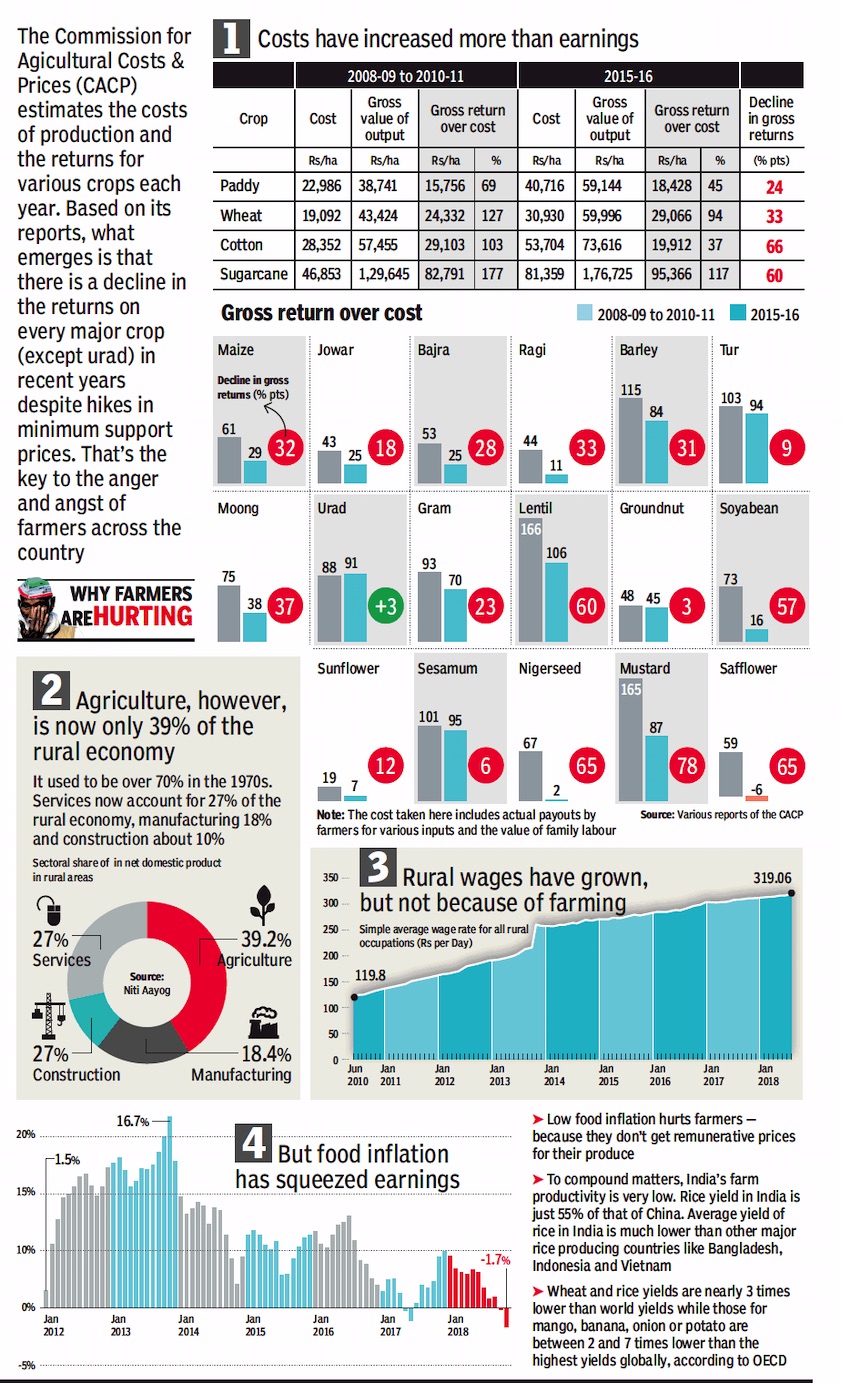
From: December 15, 2018: The Times of India
See graphic:
2008-16- How farmers’ earnings are eaten away
Incentives for farmers
Criteria For Loan Advances: Maharashtra, 2017
Bhavika Jain, Maha bows before farmers, again, June 21, 2017: The Times of India
Revises Criteria For Loan Advances Of Rs 10,000
Following pressure from farmer groups, the state government decided to revise the criteria under which the Rs 10,000 loan advance will be given to prepare for the upcoming agricultural season.
Farmers with four wheelers, who until now were not eligible for the loan advance, have also been made eligible for the scheme.The revised rule allows farmers owning vehicle up to Rs 10 lakh to take loan advance under the inititaive.
The state government had last week announced that while the larger issue of the loan waiver is being dealt with, it would give Rs 10,000 to farmers to begin preparation for this year's kharif season. However, the core committee of ministers under revenue minister Chandrakant Patil fixed some eligibility criteria for this loan advance and some of the norms were not acceptable to the farmers groups that are holding talks with the government.
Most of these norms were revised on Tuesday and a fresh notification will be issued incorporating them. One of the condition was that farmers with four wheelers will not be eligible for the advance loan, This norm has been revised and to say that farmers own who any vehicle up to Rs 10 lakh will be eligible for this instalment. Similarly , the government had decided that farmer families whose member(s) are government servant or are members of the panchayat samiti or the sugar mills administrative body will not get the benefit.Even these norms were revised -a government servant who draws a salary less that Rs 20,000 and is also a farmer can avail of this scheme. Members of the panchayat samiti and those of the administrative body of sugar mills have also been included in the eligiblilty list.
After the protest by the farmers representatives on Monday against the government's decision to cap the loan waiver at Rs 1 lakh and set the cut off date to June 30,2016, the government has said that they will no longer hold talks with the co-ordination committee of the farmers.
Income growth
2009-18: higher incomes; also higher costs
February 2, 2018: The Times of India
See graphics:
2009-18- higher incomes for food producers were accompanied by higher costs as well-Part I
2009-18- higher incomes for food producers were accompanied by higher costs as well-Part II

From: February 2, 2018: The Times of India
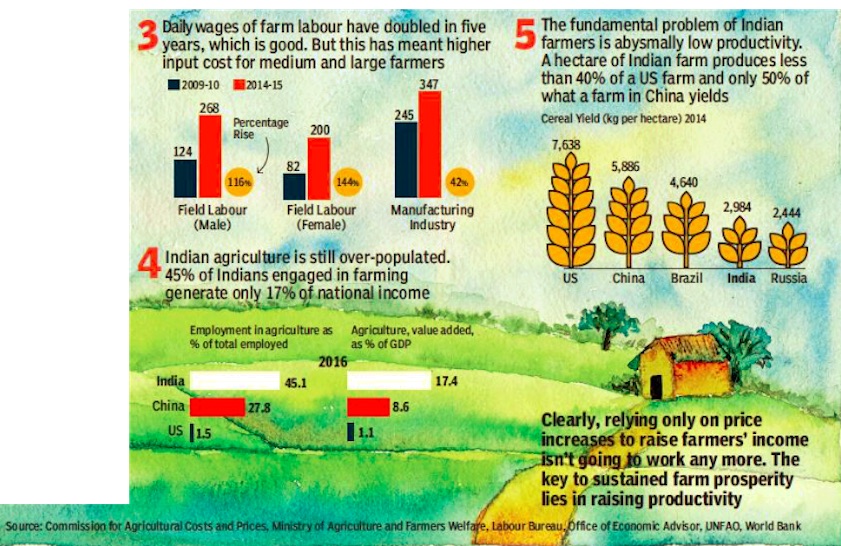
From: February 2, 2018: The Times of India
Minimum Support Price
A backgrounder
Jun 12 2017: The Times of India

See graphic:
Fixation of Minimum Support Price, the procedure
What is minimum support price?
The government fixes minimum support prices or MSPs for a selected list of crops that account for the bulk of India's cropped area. These prices are announced at the beginning of each sowing season. The government essentially guarantees to buy any of the harvest that is offered to it at this price. The assurance of remunerative prices are supposed to encourage farmers to invest more and hence increase production of these crops. If the market price after the harvest is more than the MSP , farmers would be able to get a higher return but if not, the MSP is supposed to provide a safeguard against prices falling too low.
What are the factors that determine MSP?
The MSP is fixed for 23 agricultural commodities for which the Commission for Agricultural Costs and Prices (CACP) is required to give recommendations to the government. Various criteria encompassing the interests of both producers and consumers are used for fixing the MSP . The commission assesses demand and supply by sending questionnaires and holding discussions with government agencies and various trade and industry bodies.
Do all farmers get benefited by MSP?
A 2016 NITI Aayog evaluation report on MSP that studied 36 districts in 14 states showed a mixed picture. While there is general consensus among farmers that MSP should continue, there are huge implementation issues. Only 10% of the farmers surveyed were aware of MSP before the sowing season, which meant there was no incentive to have a particular crop. Also, despite knowing about MSP many farmers could not sell their products to FCI because of various logistical issues like transportation and storage. A vast majority of Indian farmers are small farmers and a delay in official procurement (which is quite frequent) forces them into distress sales of their product due to urgent need of money .Also, public procurement at MSP is largely focused on certain crops like paddy , wheat and sugarcane and on cer tain states like Punjab, Haryana, Uttar Pradesh and so on.
Why do some criticise the concept of an MSP?
They argue that political pressure increases the MSP without considering the size of the harvest. As a result, prices may not fall despite a good harvest and there could be inflationary pressure on consumers. The middle men who procure crops from marginal farmers and sell it to FCI centres would be the ones to benefit as the farmer gets a low price because of the high yield and prices will not fall correspondingly for the consumers. Also, they say large scale procurement effectively reduces the amount of the produce that reaches open markets and hence creates an artificial shortage in these markets, thereby pushing up prices.
The states and farmers that benefitted
2018-19
Vishwa Mohan, October 3, 2020: The Times of India
Just about 12% or 97 lakh of India’s over 8 crore paddy farmers benefitted from procurement operations during 2018-19 with large variations across states, reflecting the limited utility of the current minimum support price structure that seems more geared for high-volume states like Punjab and Haryana seen as the country’s granaries.
The Centre’s decision to proactively begin procurement of paddy to allay fears of protesting farmers over the fate of minimum support price (MSP) in the wake of newly enacted farm laws may not prove effective beyond a handful of states, going by an analysis of rice procurement data for 2018-19.
More than 95% paddy farmers in Punjab and about 70% farmers in Haryana were covered under procurement operations while in other major rice producing states like Uttar Pradesh (3.6%), West Bengal (7.3%) Odisha (20.6%) and Bihar (1.7%) — a very small number benefited from procurement operations. These figures can well explain why the current protests against the farm laws have not engaged farmers in these states compared to counterparts in Punjab and Haryana chiefly as also Telangana, Andhra Pradesh and Chhattisgarh.
Procurement figures of 2018-19 show that about 89% of total production of Punjab was procured while 85% of Haryana. Other states, where more than half of total rice production was procured included Telangana (62%), Chhattisgarh (57.4%) and Andhra Pradesh (50.7%). Though West Bengal (13.8%) and Uttar Pradesh (13.3%) are largest rice producing states and account for 11.2% and 11.7% of total marketed surplus of rice, their share in procurement was much lower at 4.6% and 7%, respectively.
Flagging these variations and lop-sided procurement operations in most states, the Commission for Agricultural Costs and Prices (CACP), the agriculture ministry’s body which calculates MSP, in its 2020-21 price policy for Kharif crops noted how poor access to procurement in UP, West Bengal, Odisha, Bihar and other eastern and north-eastern states forces farmers to resort to distress sale at lower than the MSP. Since, majority of farmers in these less privileged states in terms of procurement are small and marginal, they have poor access to procurement at MSP. “Therefore, concerted efforts should be made to extend the benefits of procurement to small and marginal farmers in general and eastern and NE states in particular,” said the CACP. Though the coverage of paddy procurement has expanded to more states and farmers over the years with India recording 44.4 million tonnes of procurement of rice in 2018-19 (up from 38.2 million tonnes in 2017-18), the entire operation continued to be limited to certain states despite availability of marketed surplus in other states. On the other hand, in case of top two paddy producers, West Bengal and Uttar Pradesh, less than 20% of total production was procured.
Quantitatively, the total quantity of rice procured was the highest in Punjab (11.4 million tonnes) in 2018-19 followed by Andhra Pradesh (4.2 million tonnes), Telangana (4.1 million tonnes) and Haryana (3.8 million tonnes). Punjab has the highest share of marketed surplus (13.1%) as well as procurement (28.4%), much higher than production share (11%)— indicating effective procurement systems in these two states.
1958-2017, a timeline
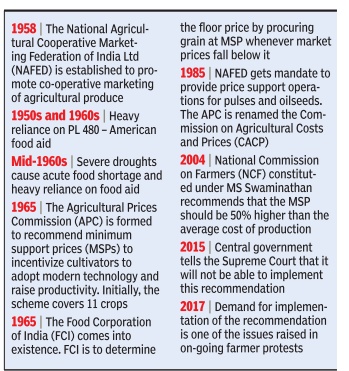
See graphic:
Minimum Support Price in India, a timeline, 1958-2017
1985-2018: increase in MSP
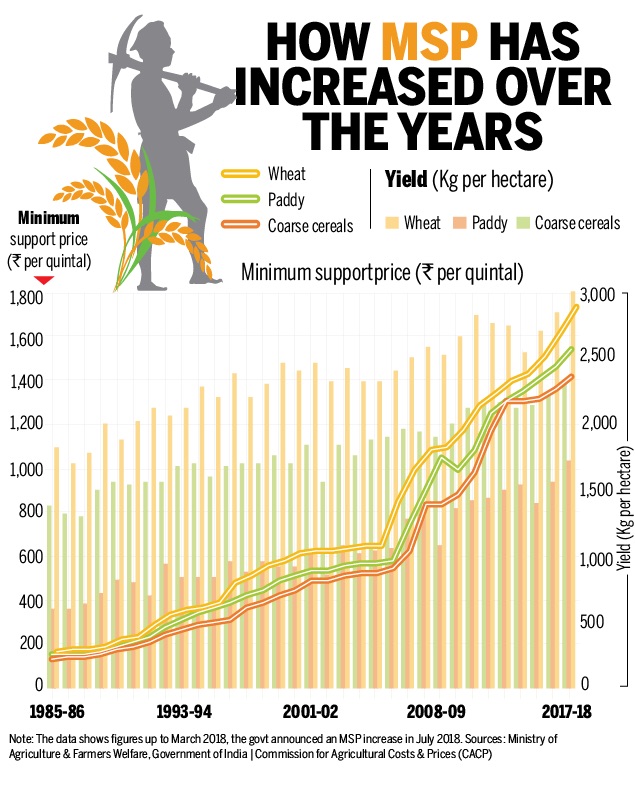
From: January 17, 2019: The Times of India
See graphic:
How MSP has increased over the years, 1985-2018
Fixing the minimum support price (MSP) to deliver remunerative prices to farmers have been at the forefront of the debate on the farm crisis. In July 2018, the govt implemented a budget promise that the govt will fix MSP at 50% over the cost. The big question is, will higher MSP end farmer crisis? Here's a look at how MSP has risen over the years.
1985-2018, MSP for wheat, paddy and coarse cereals, year-wise

From: January 17, 2019: The Times of India
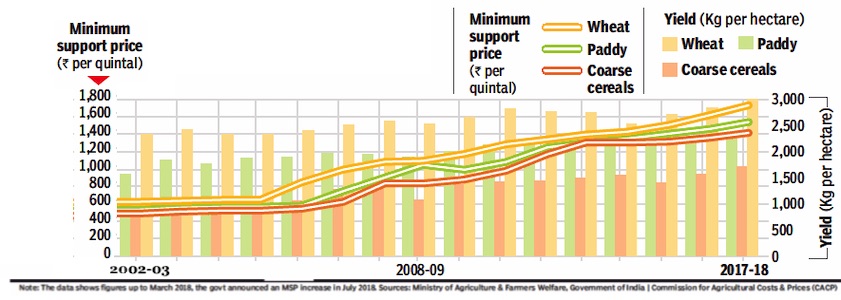
From: January 17, 2019: The Times of India
See graphics:
Minimum Support Price- wheat, paddy and coarse cereals: 1985-86 to 2001-02, year-wise
Minimum Support Price- wheat, paddy and coarse cereals, 2002-03 to 2017-18, year-wise
2018: India giving rice, wheat excess support, US tells WTO
May 10, 2018: The Times of India
India is supporting its rice and wheat farmers with payments that are far higher than the amounts allowed by the World Trade Organization (WTO), the US said in a statement published by the WTO on Wednesday.
“It appears that India provides market price support (MPS) for wheat and rice vastly in excess of what it has reported to the WTO,” the US statement said. “India’s apparent MPS for wheat appears to have been over 60% of the value of production in each of the last four years for which India has notified data. Its apparent MPS for rice appears to have been over 70%.”
Anything over 10% would break WTO rules, it added. India has made reform of agricultural subsidies a major negotiating issue at the WTO in the past five years.
It has won preliminary WTO backing for a system of public stockholding of farm produce for food security purposes, but the US and others have been wary of its plans, warning that payments which encourage production could lead to oversupply and potentially a spillover onto world markets. In its analysis, the United States looked at India’s payments for the four most recent years that it had notified to the WTO, from 2010-11 to 2013-14.
The US statement said that India was the world’s second or third largest agricultural producer.
‘Kharif MSP to be 150% of production cost:’ PM, 2018
June 30, 2018: The Times of India
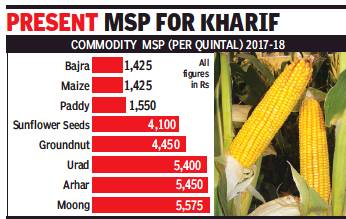
From: June 30, 2018: The Times of India
Prime Minister Narendra Modi said the government would fix the minimum support price (MSP) for kharif crops at 150% of the production cost, in line with the promise to compensate farmers and tackle distress in rural areas.
The government will announce the MSP for kharif crops next week after the Union cabinet approves the move, Modi told sugarcane farmers in an interaction at his residence. This is part of the government’s effort to double farmers income by 2022, a poll promise of BJP, and ends speculation regarding the delay in fixing MSP rates. The PM also said the government would raise fair and remunerative price for sugarcane for 2018-19 in the next two weeks.
“It will provide incentive for those farmers whose recovery from sugarcane will be higher than 9.5%,” he said, adding that recent measures undertaken by the government had helped reduce cane arrears by more than Rs 4,000 crore in the past 7-10 days.
The Union budget for 2018-19 had unveiled the idea of raising the MSP for farmers. In the past months, a highpowered committee of ministers has held several meetings to work out the MSP proposal considering this will require government spending from the exchequer and is likely to impact inflation.
Modi called for use of sprinkler and drip irrigation, latest farming techniques, solar pumps and solar panels in their farms. He also emphasised on value addition of crops, judicious use of farm waste, and up to 10% reduction in use of chemical fertilisers by 2022.
The MSP in 2018

From: Vishwa Mohan, MSP of 14 kharif crops hiked, millet growers to benefit, July 4, 2018: The Times of India
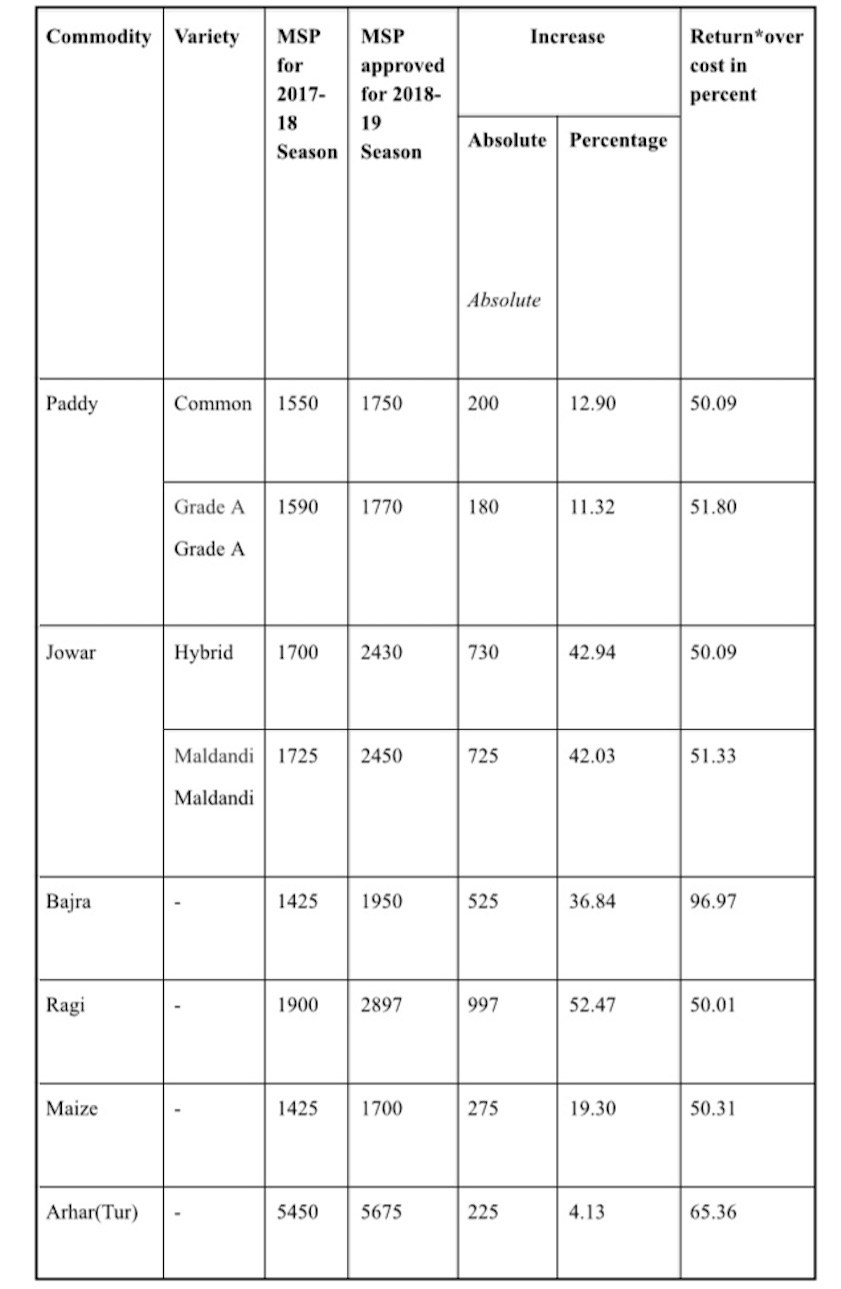
From: Vishwa Mohan, MSP of 14 kharif crops hiked, millet growers to benefit, July 4, 2018: The Times of India
The Centre hiked the minimum support price (MSP) of 14 kharif (summer sown) crops for the 2018-19 marketing season, syncing it with BJP’s 2014 poll promise to provide farmers a profit margin of at least 50% over their cost of production for all the notified crops across the country.
Seven of these 14 crops have reported hikes of nearly 20% or more as compared to the MSP of these crops in 2017-18. The most popular kharif crop, paddy, has, however, got a hike of nearly 13% (from Rs 1,550 per quintal in 2017-18 to Rs 1,750 per quintal in 2018-19).
The new MSPs of these crops were approved by the Cabinet committee on economic affairs (CCEA), chaired by Prime Minister Narendra Modi, on Wednesday. Modi later called it a “historic increase” and tweeted that the government has fulfilled its promise of increasing the MSP to the tune of one and a half times of the cost of production.
The announcement comes against the backdrop of the political imperative to fulfil the commitment to improve the deal for farmers ahead of the crucial round of state elections and the 2019 battle for the control of the Lok Sabha.
Interestingly, less-water-consuming and climate-resilient millets (jowar, bajra and ragi) — recently notified by the government as “nutri-cereals” due to their very high nutritional value — got substantial hikes as compared to the water-guzzling paddy. As compared to the acreage of paddy (396 lakh hectares), the millets currently cover nearly 120 lakh hectares of land during kharif season — less than one-third of the acreage of paddy.
The move on millets may help the government politically in the three poll-bound states of Madhya Pradesh, Rajasthan and Chhattisgarh where water-stressed farmers invariably go for cultivation of coarse cereals, but would also be welcomed by those who have been calling for greater support for the producers of coarse grains citing their nutritional value as well as the fact that they are consumed by the “not-so-privileged”.
Analysis of new MSP shows that paddy farmers will get a return of 50% over the cost of production, but the ones who opt for bajra (pearl millet) will get nearly 97% returns and those who go for arhar (pulse) will get returns of over 65%.
The larger message of the new MSP regime is to encourage farmers to cultivate pulses, oilseeds and millets. Pulses and millets will ensure nutritional security while more oilseed production will help reduce the import bill.
Among nutri-cereals, the MSP of Bajra has been increased by Rs 525 per quintal, jowar (hybrid) by Rs 730 per quintal and ragi by Rs 997 per quintal in absolute terms as compared to the support price of 2017-18. However, the highest percentage increase in MSP over the previous year is seen by ragi (52.5%). As far as returns over the cost of production are concerned, bajra farmers will get the highest profit of 97%.
“This will increase the income of farmers and purchasing capacity, which will have an impact on wider economic activity,” Union home minister Rajnath Singh said.
Experts and farm activists, however, flagged the issue of poor procurement and inadequate cost of production formula.
“The much-hyped MSP increase is of little use for farmers unless supplemented with a robust procurement system. Such a system exists only for paddy at the moment and that too in selected states,” said Sudhir Panwar, former member of the UP planning commission.
Avik Saha, national convener of the Jai Kisan Andolan, said, “While the announcement sounds grand and farmer-friendly, let us not forget that announcing MSP and not doing anything to ensure that farmers get MSP has become a political tool.”
Both agriculture minister Radha Mohan Singh and food minister Ram Vilas Paswan, however, expressed their confidence on the procurement front.
Many farm activists expressed unhappiness over the formula to arrive at the cost of production. They said the government should have taken C2 (comprehensive cost including imputed rent on owned land and interest on value of owned capital assets) formula into account instead of the A2+FL formula.
The A2+FL includes all paid-out costs such as those incurred on account of hired human labour, bullock labour/machine labour, rent paid for land, expenses incurred on use of material inputs like seeds, fertilisers, irrigation charges, depreciation on implements, miscellaneous expenses, and imputed value of family labour.
2018: The MSP approved by the govt.
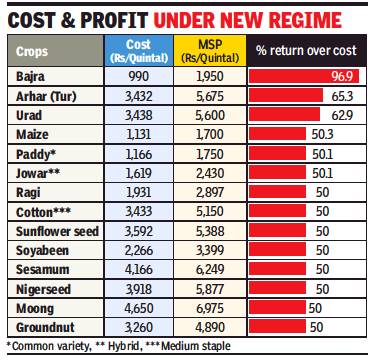
From: Vishwa Mohan, MSP of 14 kharif crops hiked, millet growers to benefit, July 5, 2018: The Times of India
The Centre hiked the minimum support price (MSP) of 14 kharif (summer sown) crops for the 2018-19 marketing season on Wednesday, syncing it with BJP’s 2014 poll promise to provide farmers a profit margin of at least 50% over their cost of production for all the notified crops across the country.
Seven of these 14 crops have reported hikes of nearly 20% or more, compared with the MSP of these crops in 2017-18. The most popular kharif crop, paddy, has, however, got a hike of nearly 13% (from Rs 1,550 per quintal in 2017-18 to Rs 1,750 per quintal in 2018-19).
The new MSPs were approved by the Cabinet committee on economic affairs, chaired by Prime Minister Narendra Modi, on Wednesday. Modi later called it a “historic increase” and tweeted that the government has fulfilled its promise of increasing the MSP to the tune of one-and-a-half times of the cost of production.
Bajra farmers to get 97% returns over input cost
The announcement, which was made by home minister Rajnath Singh, comes against the backdrop of the political imperative to fulfil the commitment to improve the deal for farmers ahead of the crucial round of state elections and the 2019 battle for the control of the Lok Sabha.
Interestingly, less-waterconsuming and climate-resilient millets (jowar, bajra and ragi) — recently notified by the government as “nutri-cereals” due to their very high nutritional value — got substantial hikes as compared to the water-guzzling paddy. As compared to the acreage of paddy (396 lakh hectares), the millets currently cover nearly 120 lakh hectares of land during kharif season — less than one-third of the acreage of paddy.
The move on millets may help the government politically in the three poll-bound states of Madhya Pradesh, Rajasthan and Chhattisgarh where water-stressed farmers invariably go for cultivation of coarse cereals, but would also be welcomed by those who have been calling for greater support for the producers of coarse grains citing their nutritional value as well as the fact that they are consumed by the “notso-privileged”. Analysis of new MSP shows that paddy farmers will get a return of 50% over the cost of production, but the ones who opt for bajra (pearl millet) will get nearly 97% returns and those who go for arhar (pulse) will get returns of over 65%.
The larger message of the new MSP regime is to encourage farmers to cultivate pulses, oilseeds and millets. Pulses and millets will ensure nutritional security while more oilseed production will help reduce the import bill.
Among nutri-cereals, the MSP of Bajra has been increased by Rs 525 per quintal, jowar (hybrid) by Rs 730 per quintal and ragi by Rs 997 per quintal in absolute terms as compared to the support price of 2017-18.
Rabi

From: Vishwa Mohan & Dipak Dash, MSP for rabi crops hiked after kisan fury, October 4, 2018: The Times of India
A day after facing intense farmers’ protests over multiple issues at Delhi-Uttar Pradesh border, the Centre hiked the minimum support price (MSP) of all six rabi (winter sown) crops. The move will ensure minimum 50% return to farmers over cost of production of all notified crops.
The rabi crops, covered under the hike, include wheat, barley, gram, lentil (Masur), mustard and rapeseed and safflower. The MSP of 14 kharif (summer sown) crops had been increased in July for the marketing season which began this month.
“The MSP hike of both kharif and rabi crops this year will give additional return of Rs 62,635 crore to the farmers as now all the notified crops will fetch them minimum 50% return over cost of production,” said Union agriculture minister Radha Mohan Singh.
Officials in the agriculture ministry said the move of MSP hike had nothing to do with the farmers’ protests. “The matter was scheduled in advance for approval by the Cabinet on Wednesday. Since the government in its budget promised return of minimum 50% to farmers over their cost of production of all notified crops, the hike for rabi crops has been in the pipeline in tune with the increase in support price of kharif crops,” said an official.
An analysis of cost of production of rabi crops shows that the farmers will get maximum return of 112.5% if they opt for cultivating wheat followed by 89.9% for mustard and rapeseed, 76.7% for lentil, 75.2% for gram, 67.4% for barley and 50.1% for safflower.
As against the cost of production of Rs 866 per quintal for wheat, the government fixed its new MSP at Rs 1,840 per quintal — return of 112.5% over cost. Similarly, the new support price of rapeseed and mustard will be Rs 4,200 per quintal as against cost of production of Rs 2,212 per quintal; Rs 4,475 per quintal against cost of Rs 2,532 per quintal for lentil; Rs 4,620 per quintal against cost of Rs 2,637 per quintal for gram; Rs 1,440 per quintal against cost of Rs 860 per quintal for barley and Rs 4,945 per quintal against cost of Rs 3,294 per quintal for safflower.
Except for safflower, all other rabi crops had provided more than 50% return to farmers even last year.
Crops that were the biggest and smallest gainers
Coarse grains get farmers good returns, November 17, 2018: The Times of India

From: Coarse grains get farmers good returns, November 17, 2018: The Times of India
Earlier in 2018, FM Arun Jaitley had announced that the government would increase minimum support price for agricultural products this kharif season to ensure that farmers get at least 50% higher returns than the cost of production. Coarse grains, this year, have seen the highest jump in returns and grains like ragi, sunflower seeds, jowar and bajra have grown fastest. The states that have benefited from this the most are Rajasthan, Maharashtra, Karnataka which have the highest acreage--186.8 lakh hectares--growing coarse grains.
India’s sugarcane subsidies are 1,000% of permissible limits: Australia
Australia drags India to WTO on sugar subsidies, November 17, 2018: The Times of India

From: Australia drags India to WTO on sugar subsidies, November 17, 2018: The Times of India
India’s annual subsidies to sugarcane producers have breached the allowed limits by 10-fold in the past six years, Australia told the World Trade Organization (WTO) in a document published by the world body. India’s support for producers is supposed to be capped at 10% of the value of production, but it had paid between 77.1% and 99.8% since 2011, with payments between $9.3 billion and $11.8 billion, Australia said.
The Australian challenge to India follows a US call for transparency at WTO, which President Donald Trump has threatened to quit if it does not “shape up”. Australia said India had not reported any subsidies for sugarcane or its derived products since 1995-96, when WTO was created, but evidence Australia had collected showed the actual payments were “vastly in excess of the limits”.
Australia said it was ready to discuss its findings with India and other WTO members, as well as the impact of the payments on global markets. “As the world’s second largest sugar producer and fourth largest exporter, dynamics in India's sugar market have significant implications for both prices and trade in the global market,” it said.
Government officials said India’s production subsidies to cane growers and some internal freight incentives do not violate WTO rules. Although Australia’s analysis looked at the national picture, state-level payments made the breach even bigger, it said. Major sugar producing states of UP, Maharashtra and Karnataka had state-advised prices above the national minimum, adding a further Rs 12250 crore in 2016-17 alone, Australia said. Washington has demanded transparencyfrom WTO’s 164 members, which are obliged to promptly report subsidies and other trade-related policies, to stop them hiding illicit practices or breaches of the rules.
The US has published “counter-notifications” on behalf of China, India and Vietnam to highlight what it says are failures to report honestly at WTO, and it has urged others to do the same.
MSP issues, as in 2020
December 2, 2020: The Times of India
Here’s why farmers fear states may junk MSP system under new laws
What is Minimum Support Price (MSP)?
A stable price environment is considered important to boost agricultural production. To bring that about, a central government body, Commission for Agricultural Costs & Prices (CACP), recommends MSP for 23 commodities. MSP is decided on the basis of seven criteria, of which cost of production is the most important. MSP is a part of the package to ensure food security and keep adequate food stocks in the public distribution system. After harvest, the Centre’s Food Corporation of India (FCI) procures commodities at MSP for use in the PDS.
In practice, MSP and procurement are effective for only two commodities, paddy and wheat.
Do all farmers get to sell at MSP?
No. Barely 12% of paddy growers, for example, benefit from procurement at MSP. This is because the effort put in by state governments influences where the grain is procured. The last mile aggregation is often done by state governments. Where they have been successful, the farmers benefit more. But the bill for the procurement is picked up by the Centre.
In Punjab, more than 95% of paddy growers benefit from MSP, whereas in UP only 3.6% of farmers benefit.
What are Agricultural Produce Marketing Committees (APMCs)?
They are physical markets regulated by respective state governments under the APMC Act. These legislations are not uniform across states. The Centre told the Lok Sabha in March 2017 that India has 6,630 APMCs. On an average, one APMC serves a geographical area of 496 sq km. Typically, it’s only stocks brought to APMCs and other designated purchase centres that are procured at MSP.
Does MSP make a difference to the farmer?
In the case of paddy, the average market price of paddy remained below MSP for the last five seasons. In the case of wheat, there was a lot more convergence of market price and MSP. CACP data however shows that where MSP works, like Punjab, market price is usually in line with it. Where procurement at MSP is limited, like UP and West Bengal, the market price on most days is below MSP. Where the procurement system works well, it seems to favour all farmers as the market price and MSP largely converge.
What are the new central farm laws?
It’s a package which dilutes essential commodities regulations, helps contract farming and provides for setting up new agricultural markets under central legislation as competition to APMCs.
The last part, which goes under the name Farmers’ Produce Trade and Commerce (Promotion & Facilitation) Act, is the one that has triggered anxiety. It creates an entirely new market space with practically no entry barriers for traders. But more importantly, it does not provide for taxes or levies on transactions.
Why shouldn’t farmers welcome competition?
To go back to the MSP system, it works well where states have made the effort. They usually levy taxes on the procurement that may be used to provide infrastructure. Punjab and Haryana, for example, levy a standalone rural development fee of 3% and 2% respectively. The fear comes from the possibility that if there are two markets buying the same commodities but only one of them levies a tax, trade will inevitably shift to the one without a tax.
The fear appears to be that states without enough tax revenue or resources may be disinclined to keep the existing MSP system going. For other products such as fruits and vegetables, most states had earlier removed the legal monopoly APMCs originally had. By 2019, 17 states had removed fruits and vegetables’ monopoly from APMCs and 19 had provisioned contract farming into their respective APMC Acts.
If MSPs have led to environmental damage in Punjab and Haryana and pushed down water tables, why don’t farmers switch to other crops?
The collateral damage of the current system is widely acknowledged, including by the farmers. The reluctance to shift out to a less resource intensive cereal like maize is because the prices are not remunerative. CACP admits farmers in Punjab and Haryana don’t have an incentive to switch.
The lure of the current MSP system for farmers is best brought out by the trends in Madhya Pradesh, the emerging star in the procurement system. In MP, the state government carries out procurement of wheat and paddy. This year, MP surpassed Punjab in wheat procurement, topping the list. More importantly, in just two years, wheat procurement at MSP in the state has increased from 46% of total production to 70% of production.
Other states have joined the bandwagon. In 2018-19, 9.7 million farmers benefitted from paddy procurement at MSP, an increase of 34.2% in a year. Most of the new beneficiaries were from states such as Chhattisgarh, Telangana, UP and West Bengal.
The govt’s expectations from the 3 new laws

From: December 9, 2020: The Times of India
See graphic:
The govt’s expectations from the 3 new farm laws of 2020
Number/ population of farmers
1951-2011
See graphic, 1951-2011: The falling number of cultivators and agricultural labour.
2001> 2011: Farmer population falls by 9m
Absolute Number Of Cultivators Has Fallen First Time In Four Decades, Stands At 119m
By Rukmini Shrinivasan, The Times of India , 2013/05/01
There are now nearly 9 million fewer farmers than there were in 2001, the first time in four decades that the absolute number of cultivators has fallen.
Census data released on Tuesday shows that while the proportion of cultivators to the total workforce has been falling steadily, this is the first time since 1971 that the number of cultivators has fallen in absolute terms.
The office of the Registrar General of India on Tuesday released the primary abstract of census data, which gives the final numbers for India’s population, literacy rates and sex ratio, as also the number and types of workers. Workers are split into four industrial categories: cultivators, agricultural labour, household industry workers and others. Cultivators remain the second-largest group at 119 million after ‘others’ but are now less than a quarter of the total workforce, a decline of over 7 percentage points over 2001.
Over the last 50 years, the proportion of farmers to the total population has been in steady decline, but the fall has not been big enough for the absolute number to go down, given population increases. But in the last decade, the fall in farming has combined with the slowing rate of population growth to create a fall in the absolute numbers of farmers.
As in previous decades, the proportion of agricultural labour has increased; there are now 144 million agricultural labourers, 30% of the total worker population against 26.5% in 2001. “The rise in agricultural labour could be explained by the falling size of land holdings over time,” census commissioner C Chandramouli suggested.
Between cultivators and agricultural labour, there are now 263 million people working in agriculture, over half of all workers. Even as there has been a 3.6 percentage point decline in the proportion of people working in agriculture over the last decade, their absolute number has increased from 234 million a decade ago.
The census also confirms trends thrown up by the National Sample Survey Organization, which is the rise of casual and irregular work. The proportion of ‘main workers’ – those who have worked at least six of the last 12 months – has fallen by 2.6 percentage points, while the proportion of marginal workers – those who worked between 0 and six of the last 12 months – has risen. Within marginal workers, over 80% had worked for at least three months, Chandramouli said.
The census also confirms that female participation in the workforce has fallen slightly while it has risen for men. Delhi, Punjab and Chandigarh have India’s lowest female workforce participation rates, Delhi being the nation’s lowest.
See also
Agriculture: Indian government data
Farmers, cultivators and their issues including Farm loans

